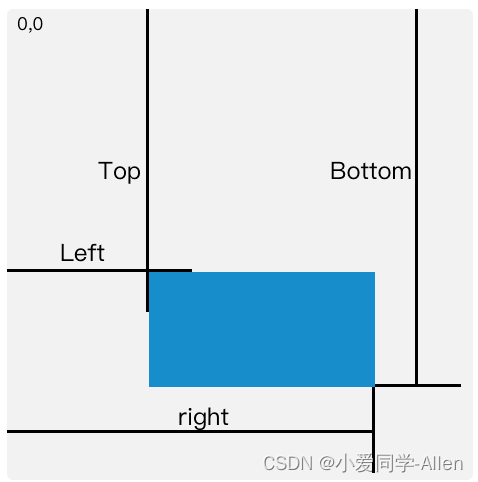目录
一. 关于希尔排序
二. 希尔排序的实现过程
三. 希尔排序的代码实现
1. 核心代码
2. 修改后的代码
四. 代码展示
五. 数据测试
六. 总结与反思
一. 关于希尔排序
希尔排序按其设计者希尔(Donald Shell)的名字命名,该算法由希尔在 1959 年所发表的论文“A high-speed sorting procedure”中所描述。1961年,IBM 公司的女程序员 Marlene Metzner Norton(玛琳·梅茨纳·诺顿)首次使用 FORTRAN 语言编程实现了希尔排序算法。在其程序中使用了一种简易有效的方法设置希尔排序所需的增量序列:第一个增量取待排序记录个数的一半,然后逐次减半,最后一个增量为 1。该算法后来被称为 Shell-Metzner 算法。
希尔排序可以说是排序算法里面最特别的一种存在,它是集合了直接插入算法的两种特殊情况改进而来。我们对直接插入排序进行讨论:例如若待排序列为“正序”时,其时间效率可以提升至O(n),由此可见直接插入更适用于①基本有序②数据量不大的表。希尔排序正是基于这两点分析对直接插入排序进行改进而来,又称缩小增量排序。
希尔排序是基于插入排序的以下两点性质而提出改进方法的:
1. 插入排序在对几乎已经排好序的数据操作时,效率高,即可以达到线性排序的效率。
2. 但插入排序一般来说是低效的,因为插入排序每次只能将数据移动一位。
(最特别的是希尔排序的平均时间复杂度是,这在排序算法里面几乎是最具有辨识度的存在)
二. 希尔排序的实现过程
希尔排序的的基本思想是:先将待排序表分割成若干形如的“特殊”子表,即把相隔某个“增量”的记录组成一个子表,对各个子表分别进行直接插入排序,当整个表中的元素已呈“基本有序”时,再对全体记录进行一次直接插入排序。
希尔排序的过程如下:先取一个长度小于n的步长,把表中的全部记录分成
组,所有距离为
倍数的记录放在同一组,在各组内部进行直接插入排序;然后取第二个步长
,重复上述过程,直到所取到的
,即所有记录已放在同一组中,再进行直接插入排序,由于此时已经具有较好的局部性,故可以很快得到最终的结果。
第一趟排序结果如图所示:
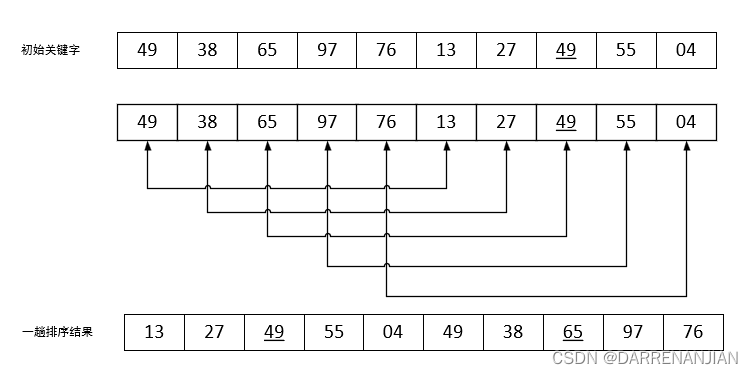
第二趟排序结果如图所示:
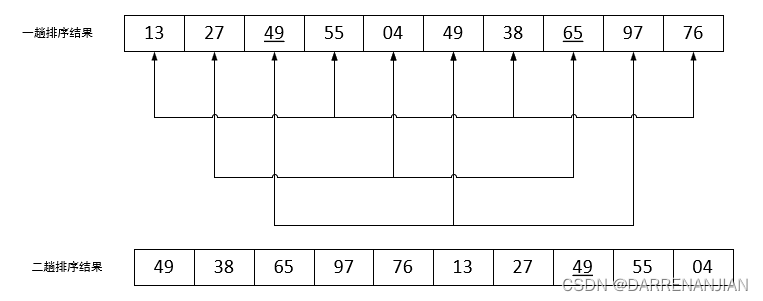
第三趟排序结果如图所示:

三. 希尔排序的代码实现
1. 核心代码
第一层循环是确定步长的大小和进行多少次步长的更新;第二层循环是确定一个步长内有多少组数据;第三个循环和第四个循环是对同一个步长里面同一组的数据直接插入排序。这里和书上的有点不同,这里用了四次循环,后面我将再讨论和书上的不同。
/**
*********************
* Shell sort. We do not use sentries here because too many of them are needed.
*********************
*/
public void shellSort() {
DataNode tempNode;
int[] tempJumpArray = { 5, 3, 1 };
int tempJump;
int p;
for (int i = 0; i < tempJumpArray.length; i++) {
tempJump = tempJumpArray[i];
for (int j = 0; j < tempJump; j++) {
for (int k = j + tempJump; k < length; k += tempJump) {
tempNode = data[k];
// Find the position to insert.
// At the same time, move other nodes.
for (p = k - tempJump; p >= 0; p -= tempJump) {
if (data[p].key > tempNode.key) {
data[p + tempJump] = data[p];
} else {
break;
} // Of if
} // Of for p
// Insert.
data[p + tempJump] = tempNode;
} // Of for k
} // Of for j
System.out.println("Round " + i);
System.out.println(this);
} // Of for i
}// Of shellSort2. 修改后的代码
这里用的三重循环,第一重循环和上面其实是一样的,只不过闵老师用了一个确定的数组来设定步长,我是根据数据长度来设定的步长。
最重要的是第二重和第三重循环这里等同于上面的第二,三,四重循环。不一样的地方在于我是对于同一步长分类完成之后直接插入排序,而闵老师是根某一个步长先将数据分成几个小组,再将同一个小组的数据进行直接插入排序;相当于后面修改的代码将闵老师的第二,三重循环合并了。
/**
*********************
* Shell sort. We do not use sentries here because too many of them are needed.
*********************
*/
public void shellSort1() {
DataNode tempNode;
int tempJump;
int position;
int i;
int round=1;
for (tempJump = length / 2; tempJump >= 1; tempJump = tempJump / 2) {
for (position = tempJump; position< length; position += 1) {
tempNode = data[position];
// Find the position to insert.
// At the same time, move other nodes.
for (i = position - tempJump; i >= 0&&tempNode.key<data[i].key; i -= tempJump) {
data[i+tempJump]=data[i];
} // Of for i
// Insert.
data[i + tempJump] = tempNode;
} // Of for position
System.out.println("Round " + round);
System.out.println(this);
round++;
}
}// Of shellSort四. 代码展示
主类:
package Day_44;
import Day_41.DataArray;
import Day_41.DataArray;
public class demo1 {
/**
*********************
* The entrance of the program.
*
* @param args Not used now.
*********************
*/
public static void main(String args[]) {
// System.out.println("\r\n-------sequentialSearchTest-------");
int []paraKeyArray;
paraKeyArray=new int[]{11,2,3};
String[] paraContentArray = new String[]{"121","21","324"};
DataArray test=new DataArray(paraKeyArray,paraContentArray);
// test.insertionSort();
// System.out.println("Result\r\n" + test);
test.shellSortTest();
}// Of main
}调用类(我喜欢将同一个类的代码写到一起,这样虽然长一点,但是更全面):
package Day_41;
/**
* Data array for searching and sorting algorithms.
*
* @author Jian An 2569222191@qq.com.
*/
public class DataArray {
/**
* An inner class for data nodes. The text book usually use an int value to
* represent the data. I would like to use a key-value pair instead.
*/
class DataNode {
/**
* The key.
*/
int key;
/**
* The data content.
*/
String content;
/**
* ********************
* The first constructor.
* ********************
*/
DataNode(int paraKey, String paraContent) {
key = paraKey;
content = paraContent;
}// Of the first constructor
/**
* ********************
* Overrides the method claimed in Object, the superclass of any class.
* ********************
*/
public String toString() {
return "(" + key + ", " + content + ") ";
}// Of toString
}// Of class DataNode
/**
* The data array.
*/
DataNode[] data;
/**
* The length of the data array.
*/
int length;
/**
* ********************
* The first constructor.
*
* @param paraKeyArray The array of the keys.
* @param paraContentArray The array of contents.
* ********************
*/
public DataArray(int[] paraKeyArray, String[] paraContentArray) {
length = paraKeyArray.length;
data = new DataNode[length];
for (int i = 0; i < length; i++) {
data[i] = new DataNode(paraKeyArray[i], paraContentArray[i]);
} // Of for i
}// Of the first constructor
/**
* ********************
* Overrides the method claimed in Object, the superclass of any class.
* ********************
*/
public String toString() {
String resultString = "I am a data array with " + length + " items.\r\n";
for (int i = 0; i < length; i++) {
resultString += data[i] + " ";
} // Of for i
return resultString;
}// Of toString
/**
* ********************
* Sequential search. Attention: It is assume that the index 0 is NOT used.
*
* @param paraKey The given key.
* @return The content of the key.
* ********************
*/
public String sequentialSearch(int paraKey) {
data[0].key = paraKey;
int i;
// Note that we do not judge i >= 0 since data[0].key = paraKey.
// In this way the runtime is saved about 1/2.
// This for statement is equivalent to
//for (i = length - 1; data[i].key != paraKey; i--);
for (i = length - 1; data[i].key != paraKey; i--) {
;
}//Of for i
return data[i].content;
}// Of sequentialSearch
/**
* ********************
* Test the method.
* ********************
*/
public static void sequentialSearchTest() {
int[] tempUnsortedKeys = {-1, 5, 3, 6, 10, 7, 1, 9};
String[] tempContents = {"null", "if", "then", "else", "switch", "case", "for", "while"};
DataArray tempDataArray = new DataArray(tempUnsortedKeys, tempContents);
System.out.println(tempDataArray);
System.out.println("Search result of 10 is: " + tempDataArray.sequentialSearch(10));
System.out.println("Search result of 5 is: " + tempDataArray.sequentialSearch(5));
System.out.println("Search result of 4 is: " + tempDataArray.sequentialSearch(4));
}// Of sequentialSearchTest
/**
* ********************
* Binary search. Attention: It is assume that keys are sorted in ascending
* order.
*
* @param paraKey The given key.
* @return The content of the key.
* ********************
*/
public String binarySearch(int paraKey) {
int tempLeft = 0;
int tempRight = length - 1;
int tempMiddle = (tempLeft + tempRight) / 2;
while (tempLeft <= tempRight) {
tempMiddle = (tempLeft + tempRight) / 2;
if (data[tempMiddle].key == paraKey) {
return data[tempMiddle].content;
} else if (data[tempMiddle].key <= paraKey) {
tempLeft = tempMiddle + 1;
} else {
tempRight = tempMiddle - 1;
}
} // Of while
// Not found.
return "null";
}// Of binarySearch
/**
* ********************
* Test the method.
* ********************
*/
public static void binarySearchTest() {
int[] tempSortedKeys = {1, 3, 5, 6, 7, 9, 10};
String[] tempContents = {"if", "then", "else", "switch", "case", "for", "while"};
DataArray tempDataArray = new DataArray(tempSortedKeys, tempContents);
System.out.println(tempDataArray);
System.out.println("Search result of 10 is: " + tempDataArray.binarySearch(10));
System.out.println("Search result of 5 is: " + tempDataArray.binarySearch(5));
System.out.println("Search result of 4 is: " + tempDataArray.binarySearch(4));
}// Of binarySearchTest
// ----------------------------------------------------
// ----------------------------------------------------
// ----------------------------------------------------
/**
*********************
* The second constructor. For Hash code only. It is assumed that
* paraKeyArray.length <= paraLength.
*
* @param paraKeyArray The array of the keys.
* @param paraContentArray The array of contents.
* @param paraLength The space for the Hash table.
*********************
*/
public DataArray(int[] paraKeyArray, String[] paraContentArray, int paraLength) {
// Step 1. Initialize.
length = paraLength;
data = new DataNode[length];
for (int i = 0; i < length; i++) {
data[i] = null;
} // Of for i
// Step 2. Fill the data.
int tempPosition;
for (int i = 0; i < paraKeyArray.length; i++) {
// Hash.
tempPosition = paraKeyArray[i] % paraLength;
// Find an empty position
while (data[tempPosition] != null) {
tempPosition = (tempPosition + 1) % paraLength;
System.out.println("Collision, move forward for key " + paraKeyArray[i]);
} // Of while
data[tempPosition] = new DataNode(paraKeyArray[i], paraContentArray[i]);
} // Of for i
}// Of the second constructor
/**
*********************
* Hash search.
*
* @param paraKey The given key.
* @return The content of the key.
*********************
*/
public String hashSearch(int paraKey) {
int tempPosition = paraKey % length;
while (data[tempPosition] != null) {
if (data[tempPosition].key == paraKey) {
return data[tempPosition].content;
} // Of if
System.out.println("Not this one for " + paraKey);
tempPosition = (tempPosition + 1) % length;
} // Of while
return "null";
}// Of hashSearch
/**
*********************
* Test the method.
*********************
*/
public static void hashSearchTest() {
int[] tempUnsortedKeys = { 16, 33, 38, 69, 57, 95, 86 };
String[] tempContents = { "if", "then", "else", "switch", "case", "for", "while" };
DataArray tempDataArray = new DataArray(tempUnsortedKeys, tempContents, 19);
System.out.println(tempDataArray);
System.out.println("Search result of 95 is: " + tempDataArray.hashSearch(95));
System.out.println("Search result of 38 is: " + tempDataArray.hashSearch(38));
System.out.println("Search result of 57 is: " + tempDataArray.hashSearch(57));
System.out.println("Search result of 4 is: " + tempDataArray.hashSearch(4));
}// Of hashSearchTest
// ----------------------------------------------------
// ----------------------------------------------------
// ----------------------------------------------------
/**
*********************
* Insertion sort. data[0] does not store a valid data. data[0].key should
* be smaller than any valid key.
*********************
*/
public void insertionSort() {
DataNode tempNode;
int j;
for (int i = 2; i < length; i++) {
tempNode = data[i];
//Find the position to insert.
//At the same time, move other nodes.
for (j = i - 1; data[j].key > tempNode.key; j--) {
data[j + 1] = data[j];
} // Of for j
//Insert.
data[j + 1] = tempNode;
System.out.println("Round " + (i - 1));
System.out.println(this);
} // Of for i
}// Of insertionSort
/**
*********************
* Test the method.
*********************
*/
public static void insertionSortTest() {
int[] tempUnsortedKeys = { -100, 5, 3, 6, 10, 7, 1, 9 };
String[] tempContents = { "null", "if", "then", "else", "switch", "case", "for", "while" };
DataArray tempDataArray = new DataArray(tempUnsortedKeys, tempContents);
System.out.println(tempDataArray);
tempDataArray.insertionSort();
System.out.println("Result\r\n" + tempDataArray);
}// Of insertionSortTest
// ----------------------------------------------------
// ----------------------------------------------------
// ----------------------------------------------------
/**
*********************
* Shell sort. We do not use sentries here because too many of them are needed.
*********************
*/
public void shellSort() {
DataNode tempNode;
int[] tempJumpArray = { 5, 3, 1 };
int tempJump;
int p;
for (int i = 0; i < tempJumpArray.length; i++) {
tempJump = tempJumpArray[i];
for (int j = 0; j < tempJump; j++) {
for (int k = j + tempJump; k < length; k += tempJump) {
tempNode = data[k];
// Find the position to insert.
// At the same time, move other nodes.
for (p = k - tempJump; p >= 0; p -= tempJump) {
if (data[p].key > tempNode.key) {
data[p + tempJump] = data[p];
} else {
break;
} // Of if
} // Of for p
// Insert.
data[p + tempJump] = tempNode;
} // Of for k
} // Of for j
System.out.println("Round " + i);
System.out.println(this);
} // Of for i
}// Of shellSort
/**
*********************
* Shell sort. We do not use sentries here because too many of them are needed.
*********************
*/
public void shellSort1() {
DataNode tempNode;
int tempJump;
int position;
int i;
int round=1;
for (tempJump = length / 2; tempJump >= 1; tempJump = tempJump / 2) {
for (position = tempJump; position< length; position += 1) {
tempNode = data[position];
// Find the position to insert.
// At the same time, move other nodes.
for (i = position - tempJump; i >= 0&&tempNode.key<data[i].key; i -= tempJump) {
data[i+tempJump]=data[i];
} // Of for i
// Insert.
data[i + tempJump] = tempNode;
} // Of for position
System.out.println("Round " + round);
System.out.println(this);
round++;
}
}// Of shellSort
/**
*********************
* Test the method.
*********************
*/
public static void shellSortTest() {
int[] tempUnsortedKeys = { 5, 3, 6, 10, 7, 1, 9, 12, 8, 4 };
String[] tempContents = { "if", "then", "else", "switch", "case", "for", "while", "throw", "until", "do" };
DataArray tempDataArray = new DataArray(tempUnsortedKeys, tempContents);
System.out.println(tempDataArray);
tempDataArray.shellSort1();
System.out.println("Result\r\n" + tempDataArray);
}// Of shellSortTest
}// Of class DataArray五. 数据测试
原先的代码和修改后的代码都是一样的运行结果:
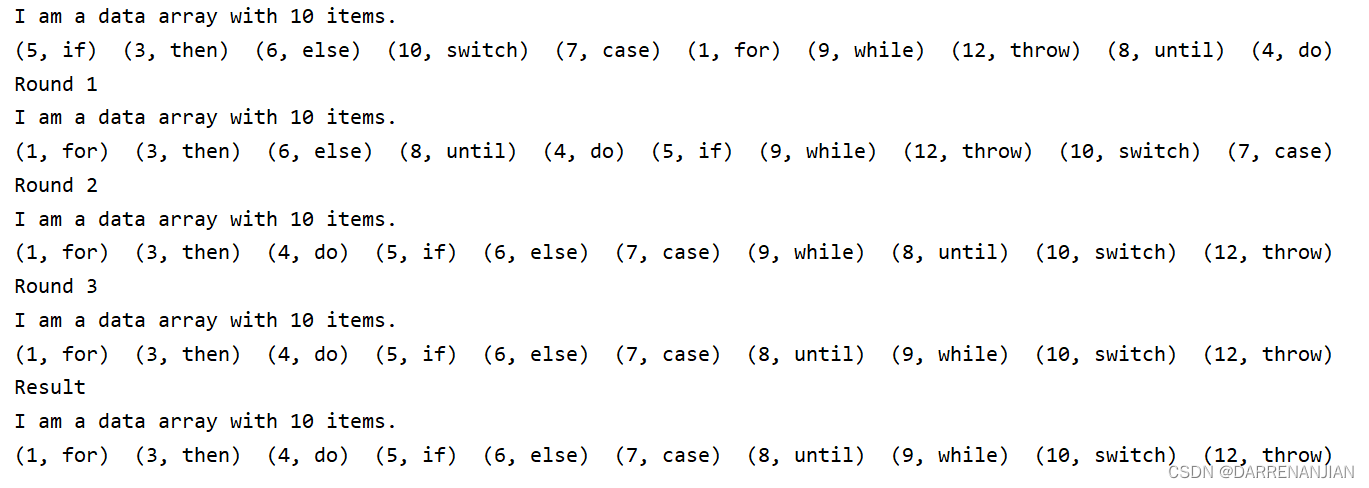
六. 总结与反思
这一小节关键思想是理解直接插入算法在①基本有序,②数据量小的前提下,排序效率很高,然后我们根据这两个线索,构造出来先设定大步长然后慢慢减小步长的算法,从而每一次都是对一个基本有序且数据量较小的数组进行排序;这样得到的最终效率是比较高的。这一小节的知识是完全从前面知识剥离出来的;告诉我们关于算法完全可以在前者的基础上更改条件构造出更好的算法。
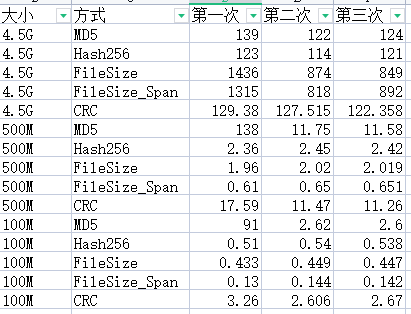
![[chatGPT攻略] 如何检测文本内容是否由ChatGPT生成 ?](https://img-blog.csdnimg.cn/016cf0517f934188a922644645a3b590.png)




